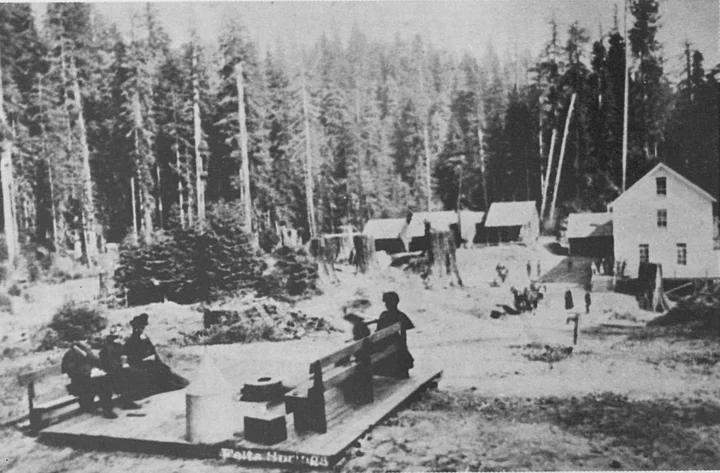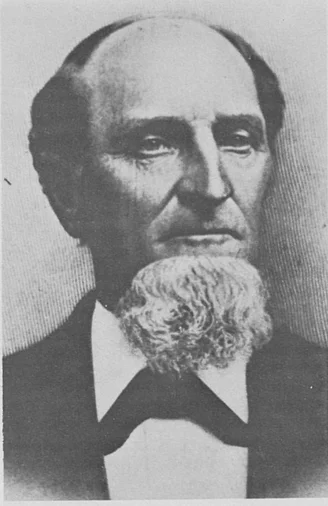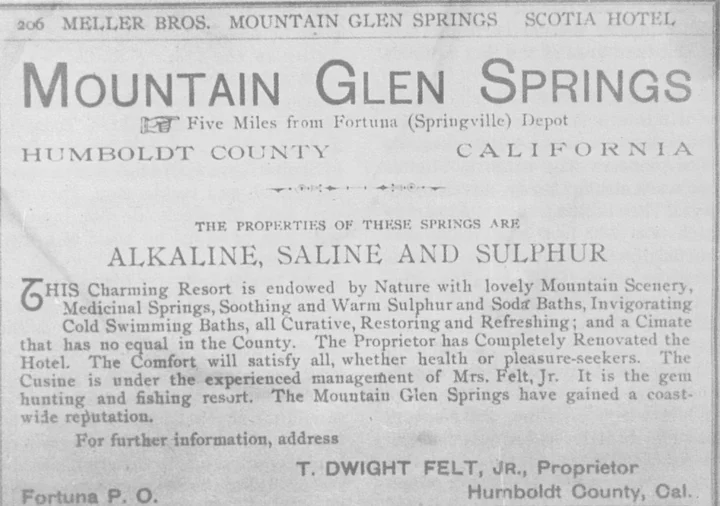A general view of the Felt Springs resort and health spa near Fortuna. Photo: Peter Fassold, courtesy Clarke Museum. Taken from the November/December 1985 issue of the Humboldt Historian.
Dr. Theodore Dwight Felt was one of the pioneer settlers in Humboldt County and, with Jonathan Clark, was one of two physicians in practice in the early 1850s. Dr. Felt originally homesteaded in the Goose Lake Prairie (now Hydesville) area and for many years was closely associated with the development of that and neighboring towns.
In addition to the practice of medicine Dr. Felt played a prominent role in numerous community and commercial ventures. One of these projects which occupied his energies for a number of years was the development of Mt. Glen Springs, or Felt Springs, as it was often called, a resort-health spa situated near Fortuna and promoted primarily on the basis of the alleged medicinal properties of the waters located there.
The springs were discovered in 1874 on land obtained through a grant to Dr. Felt. Some men employed by him returned one day saying that they had found some unusual tasting water. Upon Dr. Felt’s personal investigation he found two large mineral springs lying in a basin formed by a slide on the south side of a ridge separating Salmon Creek and Strongs Creek five miles from the town of Rohnerville. This spot lies not far from the present Newberg Road.
Dr. Felt was impressed with the quality of the water and was quick to appreciate its commercial possibilities as evidenced by the following notice which appeared in the Humboldt Times Weekly of January 24, 1874: “Mineral Water - Probably the finest and best mineral springs at the present known in the State of California is that recently discovered in this county and owned by Dr. T.D. Felt of Rohnerville. It is said to contain medicinal and curative qualties such as no other mineral water possesses. Dr. Felt has sent Mr. Fruchlicht of our Corner Saloon several gallons of the waters from the spring where the sick and curious will do well to call and give it a try.”
Soon after, development had proceeded to the point where patients could visit and stay at the springs. In the Humboldt Times Weekly of May 23, 1874, the following was recorded: “Favorable Acting: Several persons, invalids, who have come in from Felt’s Mineral Springs after a stay there of two to three weeks, give the most favorable accounts of the beneficial results experienced in their own cases from the use of the waters of those springs. For rheumatic troubles the water seems to act like a charm. Dr. Felt will have his road to the spring completed in a few days when they can be reached without trouble or inconvenience. We understand likewise that he will proceed at once to erect suitable buildings for the accommodations of visitors.”
By 1876 the enterprise must have been successful, as Dr. Felt closed his practice in Rohnerville and moved to the springs. Individual cabins and a hotel for visitors were present at this time. Unfortunately, soon after his move, in May, 1876, a disastrous fire destroyed the hotel and damaged other buildings, fortunately with no loss of life but with a property loss estimated by Dr. Felt of $50,000. With characteristic vigor Dr. Felt immediately began the rebuilding of the resort. Later in that year a new project was added — the development of a piped water system to supply the town of Rohnerville. From the Daily Humboldt Times, July 18, 1876, this notice appeared: “Felt Mineral Springs: The work of conducting the water from Mountain Glen Springs to Rohnerville through pipes is being pushed through rapidly. The pipe is already laid from the springs to the edge of the timber near Rohnerville and will be carried to Felt’s Hotel in about a week. The pipe selected for the purpose is of the finest quality and is coated with asphaltum so that it will last for many years. After this work is completed Rohnerville will be “fixed,” having a regular system of water works for protection against fire and her hotel supplied with mineral water that cures the sick.”
This is the announcement that was placed in the Humboldt County Directory of 1890-91 after Dr. Felt’s son became manager of the resort.
Bad luck intervened, however, and another fire destroyed the recently reconstructed buildings. Perhaps depressed from this turn of events and certainly in need of funds. Dr. Felt now returned to the practice of medicine in Rohnerville. Mt. Glen Springs continued now under the direction of T.D. Felt, Jr., who rebuilt the property and managed the resort. Sporadically, mention of the springs appeared in the local papers, including this note in the Humboldt Times Weekly, 1877, which gave a chemical analysis of the waters and concluded: “…proving it to be one of the finest alterative and tonic compounds ever offered to the public.”
The most detailed account of the spring waters and of the resort is found in the Humboldt County Directory, 1890-1: “The waters in these springs, although in the same basin, prove, by analysis, to be very different. But one is as desirable as the other. The water differs in color also, one having a clay or milky appearance, while the other is perfectly clear. The gas rises in each at intervals of 3-4 minutes. The waters of these springs are used for different diseases…The water is pleasant to taste and of a decidedly saline flavor, or to be more thoroughly understood, like soda. At intervals of a few minutes an effusion of gas takes place, which bubbles quite furiously and then gradually subsides, almost ceasing. The gas seems to be of a chlorotic nature, having a faint greenish-blue flame when ignited. It gives no soot or sediment and leaves no odor and the gas would remain lighted the entire night. The place is under the management of Mr. T.D. Felt, Jr., son of Dr. Felt. The hotel and cottages at the spring provide accommodation for 50-60 guests. The former hotel which could accommodate double that was burned in 1876. This is a most enjoyable place for those who seek quiet and rest. The air is pure and invigorating, the altitude being 1400 ft. above sea level. The scenery is grand and picturesque and for the suffering and ailing the remedies from nature’s own lab are here provided, which if they do not affect a cure will at least afford a relief. Hunting and fishing abound plentifully. This is one of the gem retreats of California for recreation and rest.”
Felt Springs sits just outside the western edge of what we now call Headwaters Forest.
Stages now met the 11 a.m. train arriving in Fortuna from Eureka Tuesdays and Saturdays of each week to convey visitors to the spa. Despite the suggested success of Mt. Glen Springs, it floundered and was soon closed. Time and the forest gradually reclaimed the buildings, parts of which could yet be found in the 1960s. Late in the 1960s the final remnants were cleared from the area and no trace of them remain today.
###
POSTSCRIPT, 2023: In a 2015 piece for the North Coast Journal, local historian Jerry Rohde notes that in 1852 Dr. Felt was among the Eel River Valley residents who “cosigned a letter asking residents from Humboldt Bay to help Eel River area residents massacre Indians.” — Ed.
###
CORRECTION: Thanks to the readers who noted that the original title given to this story was incorrect — these were mineral springs, not necessarily hot springs. We regret the error. — Ed.
###
The story above was originally printed in the November-December 1985 issue of The Humboldt Historian, a journal of the Humboldt County Historical Society, and is reprinted here with permission. The Humboldt County Historical Society is a nonprofit organization devoted to archiving, preserving and sharing Humboldt County’s rich history. You can become a member and receive a year’s worth of new issues of The Humboldt Historian at this link.



CLICK TO MANAGE